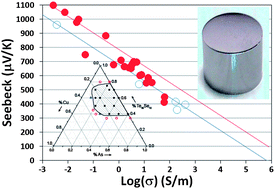Stable bulk glasses from the quaternary system Cu–As–Te–Se are investigated for thermoelectric applications. These materials exhibit a low thermal conductivity κ ∼ 0.3 W K−1 m−1 which is appealing for raising the thermoelectric figure of merit ZT. The addition of small amounts of selenium within the telluride amorphous matrix plays two fundamental roles. First, the increased disorder associated with the size mismatch improves glass-formation and widens the glass-formation domain, and second, it increases phonon scattering and slightly decreases the thermal conductivity. Furthermore, the addition of copper up to 32% dramatically increases the electrical conductivity without notably affecting the thermal conductivity. This permits us to obtain bulk glass samples with promising thermoelectric properties, which could be manufactured through conventional low-cost glass casting methods. While addition of copper permits the increase of electrical conductivity by more than six orders of magnitude, another three orders of magnitude are required to obtain thermoelectric materials with competitive ZT. Nevertheless, predicted values of ZT > 1.2 are estimated which would constitute some of the highest reported figure of merit for a bulk solid at room temperature. The effect of glass annealing on thermoelectric properties is also discussed.

You have access to this article
 Please wait while we load your content...
Something went wrong. Try again?
Please wait while we load your content...
Something went wrong. Try again?


 Please wait while we load your content...
Please wait while we load your content...